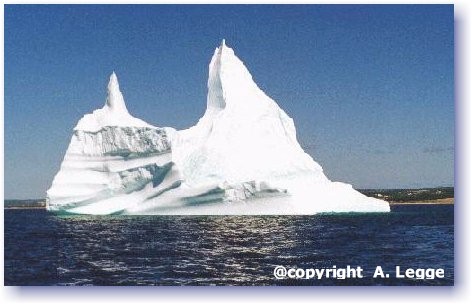|

Attention Iceberg Watchers !
Icebergs are being reported all around The Baccalieu Trail. Latest
reports indicate a great year for Icebergs right up to mid summer. If
you see an iceberg in your area email:
[email protected]
| Date |
Location |
|
June 17,2020 |
1 large Iceberg sited off Carbonear |
|
June 16,2020 |
1 very large Iceberg breaking up in Spaniard's bay |
|
June 10,2020 |
1 very large Iceberg sited in Upper Island Cove
|
|
June 9,2020 |
2 small icebergs located right next Hr. Grace
Island |
|
June 3, 2003
|
1 large Iceberg sited
of Hearts Delight -Islington |
| May 27, 2021 |
1 very large Iceberg sited
in Port de Grave |
|
May 20,2021 |
1 large Iceberg sited off Carbonear with many smaller bergs |
Contact us to post your Iceberg photos or any Iceberg Sighting.
�Some interesting facts about Newfoundland's Ice Giants. 90% of Newfoundland�s icebergs originate from the glaciers of western Greenland. As icebergs drift south in the Labrador Current they enter �Iceberg Alley� which extends south along the coast of Newfoundland. It takes approximately 2 to 3 years for this massive icebergs to reach Newfoundland covering a distance of 1600 nautical miles. The average drift speed of icebergs off the north east coast of Newfoundland is around 0.2 m/s (0.7km/h). Many bays and coves along the coast of Newfoundland can be harbouring these ice giants all summer long as some icebergs become grounded on the ocean floor. Tourist from all over the world visited Newfoundland every year to view these spectacular giants. Late Spring to early summer is considered to be the peak season for iceberg viewing. It has been determined that Newfoundland's icebergs were formed more than 15,000 years ago. Just to keep everything in perspective the saber-toothed tiger and the mighty Woolly Mammoth went extinct 9,000 -10,000 years ago at the end of the last ice age (during the Pleistocene epoch).! Getting back on track Icebergs can reach an impressive staggering height of 150-200 feet tall, 75-100 feet long, and 50-75 feet wide. An Iceberg shape is subject to change due to assorted weather factors. They can be moulded into unusual and fascinating shapes by the action of the wind and waves. The interior temperature of an iceberg can range from �15� to �20�C. Only at the outer surface does the temperature hover around 0�C (the melting point). Given that glacier ice is formed from snowfall and snow results from condense water vapour in the atmosphere, the water from icebergs is quite pure. Icebergs are comprised of pure freshwater. Icebergs are very safe to consume and are free from many of the pollutants found in today's atmosphere. In recent years, Newfoundland's iceberg industry have harvest the ice to obtain the purest water on earth for bottled water and vodka production.�
|
|